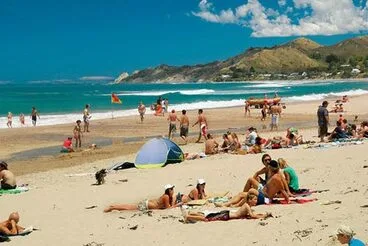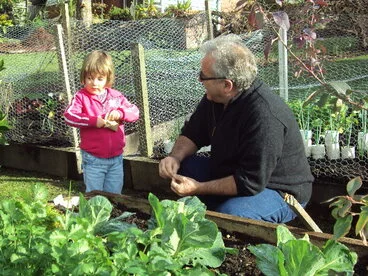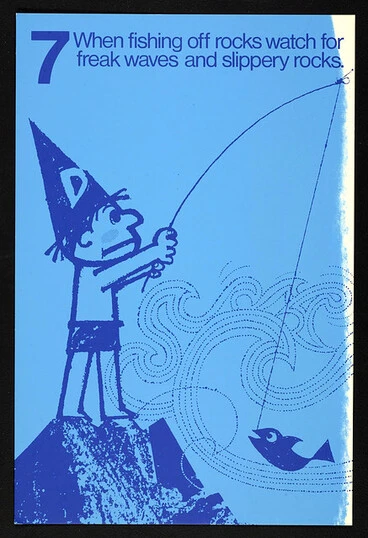New Zealand Summer
A DigitalNZ Story by National Library Services to Schools
This story covers some of the fun and adventurous ways New Zealanders enjoy summer now and in the past.
The sunny coast
Manatū Taonga, the Ministry for Culture and Heritage
BACKGROUND
Summer, from December to February, is known as raumati. One tradition holds that Te Rā (the sun) and Hine Raumati (the summer maid) had a child, Tānerore. The saying, ‘Te haka a Tānerore’ (Tānerore's war dance) refers to the shimmering of the hot air during summer.
In other traditions, Parearohi, the wife of the star Rehua (Antares), personifies heat-shimmer. When she dances around the margins of the forests, summer is approaching.
Source: The seasons — Tāwhirimātea – the weather, Te Ara - Encyclopedia of New Zealand
Summer is a time when many New Zealanders take time off to relax, enjoy family time or head for the beach. This story highlights some of the favourite sports and pastimes that make up a distinctively New Zealand summer.
The story on summer contains the following:
OUT IN NATURE
The New Zealand bush: dense forests
In New Zealand, the bush means the native forests. Tall trees tower above shrubs and younger trees. Beneath these grow ferns and mosses. Sunlight filters through the lush foliage, and birds and insects thrive. The bush is often dense and tangled, and you can easily get lost.
Māori tribes never lived within the forest, but they used the plants for food, medicines and other uses, and hunted the birds. They believed the bush was the home of gods and spirits.
European settlers found the bush very hard to travel through. For some it was gloomy and frightening.
Later, people appreciated the beauty of the remaining native forests and their unique species. A network of tracks has made it easier to walk there, and thousands of tourists visit every year. You can experience many things in the bush – from getting lost to chasing a possum!
Source: The New Zealand bush, Te Ara - The Encyclopedia of New Zealand.
New Zealand tramping
Tramping is the New Zealand term for hiking, trekking, rambling or bush-walking, and was common in print and speech by the 1920s. It is seen as a typically New Zealand activity – even though many cultures have much longer traditions of hill walking.
Enthusiasts walk along, or off, tracks in back-country settings, carrying food and gear in backpacks. Unlike mountaineering and hunting, the journey is at the centre of the tramping experience. Most trampers stay in huts, while some carry tents. A typical trip, or tramp, takes two to five days, with some lasting over a week. A tramp not involving an overnight stay is referred to as a ‘day trip’.
Source: New Zealand tramping, clubs and culture — Tramping, Te Ara - The Encyclopedia of New Zealand.
Dundle Hill walk
Manatū Taonga, the Ministry for Culture and Heritage
'Hiking on wheels'
Auckland Libraries
NZR Sponsored hike to Lake Blackwater (1937) (PB1614/7)
V.C. Browne & Son
Girl Guides Summer camp, Ness Valley, 1964
Auckland Libraries
Raukuri Nature Walk
Department of Conservation Te Papa Atawhai
TA Primary - Camp 2010
Te Awamutu Online
Meet the Locals: Gourmet tramping
Department of Conservation Te Papa Atawhai
Picnic, Tomlinson's Bush
Nelson Provincial Museum
Guided walks in the Waitakere Ranges
Auckland War Memorial Museum Tāmaki Paenga Hira
TIME FOR WATER SPORT
New Zealand has a coastline of around 15,000 km and an abundance of lakes and rivers. This makes swimming, sailing, surfing, rafting, kayaking, canoeing, and snorkelling some of the more popular summer water sports to be enjoyed.
For tips on how to keep safe in water refer to the Water safety story by Services to Schools — National Library of New Zealand
Piha.
Auckland War Memorial Museum Tāmaki Paenga Hira
Summer Child Studies series, three unidentified boys, fishing
Alexander Turnbull Library
Surfing
Manatū Taonga, the Ministry for Culture and Heritage
Transparent talent.
Manatū Taonga, the Ministry for Culture and Heritage
Rafting down the Buller River
Manatū Taonga, the Ministry for Culture and Heritage
Kayaks on Beach, Hahei, Coromandel Peninsula, North Island, New Zealand
Manatū Taonga, the Ministry for Culture and Heritage
MAKE HAY WHILE THE SUN SHINES
“Make hay while the sun shines" is an old saying that's considered a proverb. A proverb is an old, usually short saying that communicates good advice or something true.
If you make hay while the sun shines, it means that you take advantage of the chance to do something while conditions are good. In other words, you make good use of your time or make the most of an opportunity while you have the chance.
The saying has been around for hundreds of years. It first appeared in 1546 in John Heywood's A dialogue conteinyng the nomber in effect of all the prouerbes in the Englishe tongue. Experts believe the phrase came from medieval English farmers.
In New Zealand, this means time for gardening, and DIY (Do it yourself) jobs around the house that include house renovations, gardening, building a fence or literally making hay as they do on some farms around New Zealand.
Gardening
Auckland War Memorial Museum Tāmaki Paenga Hira
Men Painting House
Palmerston North City Library
Holiday job
Manatū Taonga, the Ministry for Culture and Heritage
Hay making, Rotorua
Auckland Libraries
[House renovations]
Auckland War Memorial Museum Tāmaki Paenga Hira
Five children building a fence, Mokau River
Alexander Turnbull Library
SUMMER READING
Summer reading is an important activity for children and teens to help prevent the summer slide in reading levels.
National Libary of New Zealand Services to Schools
Services to School, Public Libraries and schools have plenty of tips, challenges and programmes to keep reading in summer.
BIBLIOGRAPHY
Here are some books to help you start thinking about summer reading. Use our lending service to order these books or any others on summer.
PICTURE BOOKS
Raumati: my summer words = Ngā kupu Māori mō te Raumati by Christine Dale, 2019 (primary).
Santa's kiwi holiday by Maria Farrer, 2005 (primary).
Sun by Sam Usher, 2017 (primary).
FICTION
All summer long by Hope Larson, 2018 (primary, intermediate).
The best friend plan by Stephanie Calmenson and Joanna Cole, 2020 (primary).
A summery Saturday morning by Margaret Mahy, 2009 (primary).
What happens next by Claire Swinarski, 2020 (primary, intermediate).
NON-FICTION
The four seasons by Crystal Sikkens, 2019 (primary).
Summer by Anna Claybourne, 2019 (primary).
A trip to the beach by Maddie Spalding, 2018 (primary).
Summertime Reading Club
Christchurch City Libraries
SUMMER POSTERS
Graphic designers produce art to promote goods, services and ideas. They create layouts for advertisements, websites, books and other media. New Zealand design has always been influenced by international trends. It also has distinctive New Zealand aspects.
Source: Graphic design, Te Ara - The Encyclopedia of New Zealand.
Promoting holidays: a summer break
Manatū Taonga, the Ministry for Culture and Heritage
Folk Dance Summer School poster
Palmerston North City Library
'Buckland's Beaches, Auckland's Riviera', 1923
Auckland Libraries
When Fishing Off Rocks Watch For Freak Waves And Slippery Rocks
Archives New Zealand Te Rua Mahara o te Kāwanatanga
2007 parklands summer sounds
Christchurch City Libraries
Poster announcing Summer Holiday Show at the Dowse Art Museum opening 16th December 1983
Museum of New Zealand Te Papa Tongarewa
SUMMER SOME TIME AGO
From the 19th century many New Zealanders took holidays on the days between Christmas and New Year’s Day. By the 1920s this was common.
There were usually summer holidays for children until late January or early February. As the amount of paid annual leave for workers was extended, adults began to take holidays in January as well.
Source: Holidays, Te Ara - The Encyclopedia of New Zealand.
Summer Fashions In England
Auckland Libraries
Gordon Mirams looking at a poster advertising 'Summer Madness' in the Film Censor's Office
Alexander Turnbull Library
Taratahi-Carterton Jockey Club: Poster
Wairarapa Archive
Caught By The Camera
Auckland Libraries
Spring & Summer Fashions 1874
Auckland War Memorial Museum Tāmaki Paenga Hira
A SUMMER DIP IN THE MANUKAU HARBOUR, AUCKLAND
Auckland Libraries
Ngahape School picnic : digital image
Wairarapa Archive
SUMMER Cartoons
Ready for summer
Alexander Turnbull Library
Waiting for Summer
Alexander Turnbull Library
Summer holiday time
Alexander Turnbull Library
"Looks like another warm day in the Waikato." 17 January, 2008
Alexander Turnbull Library
"Slip! slop! slap! Slip on a shirt, slop on sunscreen and slap on a hat!" 15 December, 2004.
Alexander Turnbull Library
QUICK FACTS
• Antares known to Māori as Rehua and one of the brightest stars in the night sky is linked to summer when it becomes visible.
• Summer in the Southern Hemisphere falls in December, January and February. At this time it is winter in the northern hemisphere.
• In the 19th century when it was considered shocking to reveal too much skin people used ‘bathing machines’ to tow them out into the sea. A bather would then descend into the water from a ladder away from public view.
• The Southern Hemisphere has more water than land and this makes the climate more temperate overall as compared to the Northern Hemisphere.
• According to a Māori myth Maui and his brothers made Tamanuiterā (the sun) move slowly across the sky to make days longer.
GLOSSARY
Definitions below have been taken from the Oxford Learner's Dictionary.
distinctive — having a quality or characteristic that makes something different and easily noticed.
foliage — the leaves of a tree or plant; leaves and branches together.
personifies — to be an example of a quality or characteristic, or to have a lot of it.
A Summer's Day
Dunedin Public Art Gallery
Summer storm, Taverner Farm, Bulls
Auckland Art Gallery Toi o Tāmaki
A Summer Day, North Harbour
Auckland Art Gallery Toi o Tāmaki
OTHER RESOURCES
How Maui slowed the Sun — to make the days last longer.
Kids go gardening— has step-by-step instructions on how to grow sweet corn, avocado and strawberries.
Stuff for students — has ideas and projects for students to learn about weather and impact on the environment.
Summer sounds — is a poem by Jenny Bornholdt uses figurative language to create a typical hot summer day in New Zealand.
Summer weather — learn waiata, pūrākau and activities about Tāwhirimātea.
Tops tips for a healthy summer — from the Ministry of Health for your whānau to have an enjoyable summer break.
Girl in the Boat
Auckland Art Gallery Toi o Tāmaki
House in a Summer Garden
Waitaki District Council
Fruits of Summer by Grace Goss Acrylic $60
Kete Horowhenua
This story was curated and compiled by Te Puna Mātauranga o Aotearoa | National Library of New Zealand, Services to Schools staff, November 2020.



















![[House renovations] Image: [House renovations]](https://thumbnailer.digitalnz.org/?resize=770x&src=https%3A%2F%2Fcollection-api.aucklandmuseum.com%2Frecords%2Fimages%2Fmedium%2F576015%2F7b28d1b5db8e3ea985458f979538d1cef9046cc9.jpg&resize=368%253E)

![Summer Rock 85. Bowl of Brooklands [poster] Image: Summer Rock 85. Bowl of Brooklands [poster]](https://thumbnailer.digitalnz.org/?resize=770x&src=https%3A%2F%2Fcollection.pukeariki.com%2Frecords%2Fimages%2Flarge%2F81551%2F99eaf6c2c80f998d7504a01a7dc5a200d1dcf3ad.jpg&resize=368%253E)

















